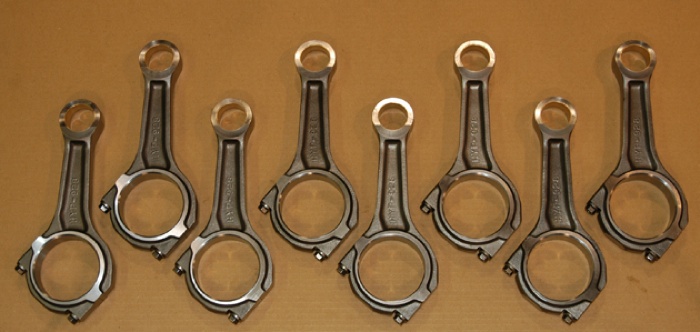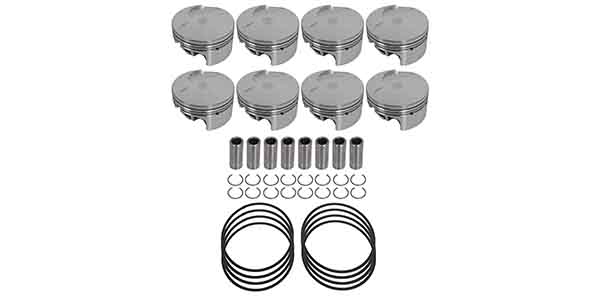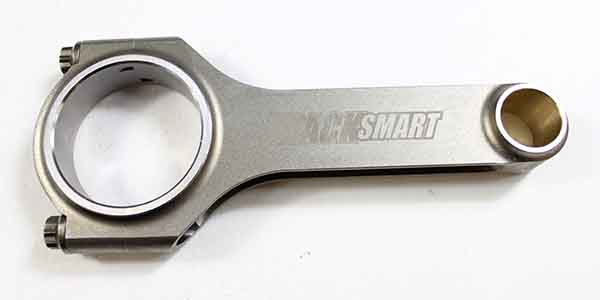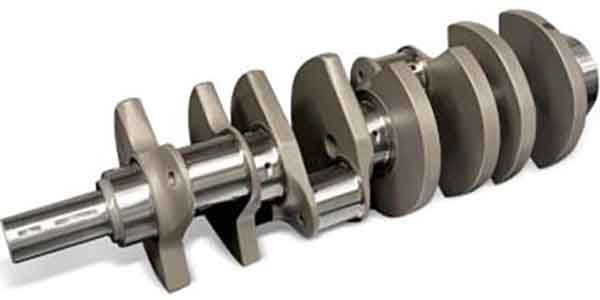 Most stock diesel engines are fairly stout for the power levels they are designed to produce. Durability and longevity are two things every diesel owner wants, and the stock crank, pistons and rods can usually provide it.
Most stock diesel engines are fairly stout for the power levels they are designed to produce. Durability and longevity are two things every diesel owner wants, and the stock crank, pistons and rods can usually provide it.
But a lot of guys also want more power! PCM reprogramming tools can simply crank up the turbo boost pressure to make an extra 100 to 200 horsepower. Such modifications usually cause no engine problems, except possible warranty issues if the OEM finds out the stock tune has been altered. The biggest issue with these kinds of tunes is breaking transmission and drivetrain components.
Most stock Cummins, Duramax and Power Stroke engines can safely handle cranking up the turbo boost to produce 500 to 600 or more horsepower. But once you get to get up around 700 to 800 horsepower in an otherwise stock motor, things start to break. Cummins engines can usually handle significant power increases with the stock crank, rods and pistons, but the stock rods are the weak link in a Duramax, especially at higher than stock RPMs.
According to Ron Knoch of the National Association of Diesel Motorsports, Cummins engines are the most popular for diesel performance. “A stock Cummins engine can usually handle a 28 percent increase in power. A Duramax engine is about the same, but Ford Power Stroke engines can only handle about a 12 percent increase in power over stock without any upgrades to the rotating components.”
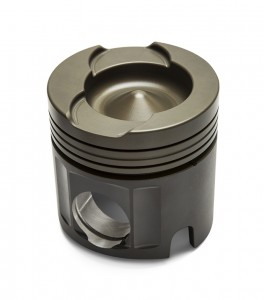
Knoch says if you’re building a performance diesel engine that will make more than 600 to 700 horsepower, you have to upgrade to stronger rods and pistons as well as high grade aftermarket cylinder head studs, rod bolts and main cap bolts. Stock cranks hold up fairly well under increased power loads, but may need to be upgraded when engine output is more than 1000 to 1200 horsepower. “Trucks that are making 1,200 to 1,500 horsepower are common today, and many highly modified ones are producing more than 2,500 horsepower!” said Knoch.
Pistons
Most stock diesel pistons are made of cast aluminum and selected for diesel engines because this allows the use of a steel insert for the upper ring. The steel insert resists ring land wear so the rings can last several hundred thousand miles. Cast pistons also have oil-cooling galleries located behind the rings to help control heat.
The aftermarket piston suppliers we interviewed for this article offer a variety of piston upgrades for diesel performance engines, including cast, forged and billet aluminum as well as steel. Some of these are “off-the-shelf” pistons that can be substituted for the stock pistons, while many are custom pistons made to specifications for the engine builder.
Stock style cast replacement pistons usually follow the OEM piston design closely, with the same ring pack, wrist pin and combustion bowl configuration. Others may offer slight modifications or enhancements such as a different ring pack, wrist pin, valve reliefs and/or bowl design.
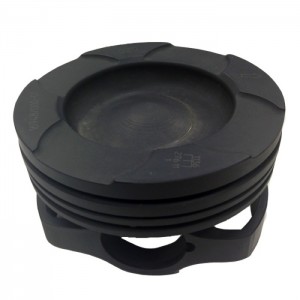
One of the changes that is often made when upgrading diesel pistons is to “de-lip” the bowl in the top of the piston. Most OEM piston designs have a “witches hat” or small peak protrusion in the center of the bowl. This helps disperse the fuel spray from the injector into the surrounding bowl. The sides of the bowl are vertical or curve up, and usually have a lip or slight overhang at the top that helps redirect the air/fuel mixture back towards the center of the bowl. This feature reduces emissions for a cleaner burn, however, in a highly modified engine that is running a lot of boost pressure, higher than normal combustion temperatures can create a problem. Heat tends to concentrate in the upper lip area of the bowl, which may lead to detonation and/or cracking in the piston.
In high-pressure common rail applications, fuel spray from the injectors can also erode the lip area of the bowl. So to reduce the risk of detonation, heat cracking and wear, the lip around the bowl is machined away and rounded off.
Some people put a 45-degree bevel on the top edge of the bowl after the lip has been removed while others round and blend the top edge of the bowl. What you don’t want is a sharp edge at the top of the bowl that could become a hot spot or promote detonation.
With custom-made pistons, there’s no need to create a lip in the first place so the bowl can be designed from the start with a more open design. Whether or not a peak is used in the center of the bowl will depend on the type of injectors used and their spray pattern. Some work better with a peak while others don’t require a peak.
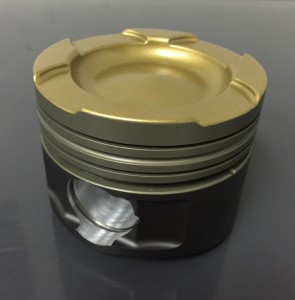
Ordering a set of custom pistons for a diesel engine isn’t difficult and most piston suppliers can easily satisfy your requirements. What they usually need to know includes:
• Engine application
• Bore size
• Rod length
• Compression ratio
• Type of injectors (stock or wider spray pattern)
• Valve reliefs (number, size & location)
• Wrist pin size
• Target weight (if you want lighter pistons for higher RPMs)
• Ring pack
• Type of coatings you want (top thermal coating, anodizing, wrist pin bore anti-wear coating, anti-scuff skirt coating)
• Type of material (cast, forged or billet aluminum)
The cost for a set of custom diesel pistons will depend on what exactly you want, who is making the pistons and how you are ordering them (direct from the piston manufacturer or through a distributor). The cost may range from $250 to $350 or more per piston. The time it takes to complete a custom order can range from several weeks to several months depending on the supplier, how busy they are, what you are ordering (cast, forged or billet) and the time of year. The key, of course, is to allow plenty of lead-time if you are ordering a set of custom pistons.
Most piston suppliers have castings to fit most common applications, and some have forgings as well, although forgings tend to be a much smaller segment of the piston business for performance diesel applications. Forgings are stronger than castings and won’t shatter like a cast piston if an engine sucks a valve, but with most forgings long-term durability has been a challenge. The reason why is because there’s no way to forge the piston around a steel insert for the upper piston ring. Also, an oil-cooling gallery can’t be created behind the rings inside a forged piston like it can in a casting. Consequently, upper ring land wear will eventually cause increased blowby and loss of power.
Hard anodizing the ring lands in a forged piston can reduce wear, but not as much as a steel insert. Because of this, some piston suppliers who offer forged aluminum diesel pistons recommend the pistons only be used for racing and not for the street. Wear is not as much of an issue with racing because the engines don’t accumulate a lot of miles.
One piston supplier applies a hard-nickel-based, anti-wear coating to the entire piston, then machine finishes the skirt and land faces to specifications. This leaves the hard coating in the ring lands, wrist pin bore and top of the piston. The hard-nickel coating in the ring lands resists microwelding and reduces land wear, allowing the pistons to be used on the street. Check with your piston suppliers for their recommendations as to whether or not a particular forged piston is suitable for street use or race only.
Billet pistons are typically used when a casting or forging is unavailable for a particular application, or where maximum strength is required to handle extremely high boost pressures and heat. Billet pistons are usually 2618-alloy aluminum, and can be machined to fit bore sizes up to 8 inches in diameter. Billet pistons are usually hard anodized, with top heat barrier coatings, anti-wear wrist pin bore coatings and/or anti-scuff skirt coatings applied as desired.
Steel pistons are another option for some applications. They cost about three times as much as cast pistons, but are extremely tough and can handle just about anything you can throw at them. One piston manufacturer currently makes steel pistons for 12- and 24-valve 5.9L Cummins engines and will soon have them for the newer 6.7L Cummins engines, as well as GMC Duramax applications. Although a steel piston is somewhat heavier than a stock cast aluminum piston, the weight difference is not as great as you might think because the steel piston uses a shorter and lighter wrist pin. The actual difference in weight on a Cummins 5.9L application is only about 100 grams per piston. For higher than stock RPMs, upgraded steel rods are recommended. The manufacturer says its steel pistons can safely handle more than 2,500 horsepower and up to 6,000 RPM with a good set of rods.
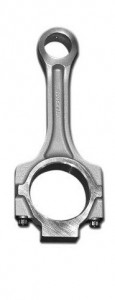
Courtesy of Hypermax Engineering.
Connecting Rods
A number of aftermarket connecting rod manufacturers offer stock and custom rods for performance diesel applications. Stronger rods are a must for higher-revving diesels and those that are running high levels of boost pressure. Both H-Beam and I-beam style rods are available, with some capable of handling upwards of 3000 horsepower. One supplier told us that Duramax rods are its best seller because of the limited abilities of the stock Duramax rods to handle significant increases in power. This rod is an H-beam 4032 billet steel design with special proprietary tool steel rod bolts. The rod comes in stock length or .200˝ longer length.
Some guys who race Cummins engines put a 5.9L crankshaft in a 6.7L block to create a 6.4L engine with a better rod stroke ratio. For these applications, a .080˝ shorter rod is required.
Another variation that some racers use is a “hybrid” Cummins rod that is longer with a Duramax wrist pin. This also improves the rod stroke ratio while reducing the rotating weight of piston and rod assembly for higher RPMs.
Although most of the performance rods for diesel applications are forged or billet steel, aluminum rods are also available. One specialty rod manufacturer makes aluminum rods for Duramax engines, but most of what it sells are forged steel for Duramax, Power Stroke and Cummins engines.
Crankshafts
Apparently, stock diesel cranks seem to hold up pretty well even at extreme power levels. One custom crankshaft supplier said the only time it sells a billet diesel crank is when somebody breaks a stock crank – which doesn’t happen that often. Many suppliers who sell custom cranks and stroker cranks for gasoline engines have not gotten into the diesel market because they haven’t seem much demand for diesel cranks. Stock replacement cranks are available from various sources, but for high-end performance applications are currently only available from a couple of suppliers, according to our sources.
The most commonly upgraded stock cranks include those for Duramax and Cummins, plus some of the agricultural tractor engines such as John Deere and International. Custom cranks are usually billet steel and are fully counterweighted. The stock Cummins and Duramax cranks don’t have center counterweights. The extra counterweights improve balance and make for a smoother, higher-revving engine.

When ordering a custom crank, the supplier will need the following information:
• The engine application
• Estimated horsepower and RPM
• Stroke
• Bore spacing
• Diameter of the main and rod journals
• Rod length
• Number of counterweights
• Design of the flywheel flange
•Internal or external balance
• Desired weight (lighter for higher RPMs)
Once the crankshaft supplier has the vital statistics, it can fabricate the crank from billet stock. Like custom pistons and rods, this doesn’t happen overnight. The crank suppliers we talked to told us to allow anywhere from 12 weeks to 6 months, and to figure on spending $4,000 to $4,500 for a custom Duramax crank, up to $6,500 for a Cummins crank, to as much as $10,000 to $12,000 for a custom John Deere or International crank.
A custom crankshaft is usually nitrited, micropolished and balanced after it has been machined to specifications. Some crank suppliers also offer a custom polishing process that leaves a mirror-like finish on all external surfaces. The crank may also be cryogenically treated to further improve its durability. Freezing the crank to several hundred degrees below zero helps stabilize the microstructure of the metal, reducing the risk of microfractures and crank failure.
Although balance may not seem to be as critical in a relatively low-revving (under 6,000 RPM) diesel engine as it is in a high-revving (9,500 RPM or higher) gasoline engine, balance always improves smoothness and reliability. The weights of many stock pistons and rods can vary quite a bit in diesel engines, so the closer these components can be matched, the more it will reduce unwanted harmonics and vibration. You don’t have to get it down to tenths of a gram, but within a couple of grams is close enough for most diesel applications. n
We thank the following suppliers for their contributions to this article: Arias, ARP, Bryant Racing, CP Industries/Carrillo Crankshafts, Diamond Racing, Federal-Mogul Motorparts, Hypermax, MAHLE Aftermarket, Wiseco and Winberg.
For more information and addresses of diesel parts supppliers visit our interactive Buyers Guides at www.enginebuildermag.com.

